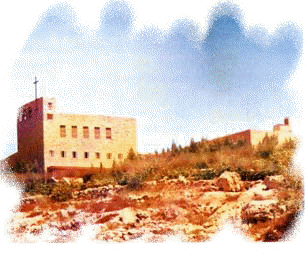![]()
|
In This Page |
|
|
|
|
|
|
Small Talitha:
American
doctor Mole represented the International Lutheran Union in asking the Kaiserswerth Association to continue their work in improving Talitha Kumi in Beit Jala through the
“Jerusalem Verein” Association. The school was re-located in Beit Jala in the
Lutheran Church's premises or grounds. Another cleric joined Sister Bertha and Sister
Najla’, her name was Sister Afifa Sam’an. In autumn of 1950, Talitha Kumi could
take in about 120 Girls. The school in Beit Jala was called “Small Talitha” .
while the school in Jerusalem which was located in King George's St, was called “Old
Talitha” .
Association to continue their work in improving Talitha Kumi in Beit Jala through the
“Jerusalem Verein” Association. The school was re-located in Beit Jala in the
Lutheran Church's premises or grounds. Another cleric joined Sister Bertha and Sister
Najla’, her name was Sister Afifa Sam’an. In autumn of 1950, Talitha Kumi could
take in about 120 Girls. The school in Beit Jala was called “Small Talitha” .
while the school in Jerusalem which was located in King George's St, was called “Old
Talitha” .
The only trace left of the old school is an Arch Gate right in front of the nowadays called “Hamashbir”, an Israeli shopping Center. The name of the school is carved on top of the arch, right under a clock and the school logo. Talitha and the association responsible for its expenses offered a lot of money for the stone on which the Talitha Kumi logo and name is carved, and they (The Israelis) still refuse to give it back.
Sister Bertha became the headmistress of the
school while sister Najla’ became responsible for the teachers’ college or
preparation section.
In “Small Talitha” there were many available spaces for new
comers; Despite that, the nuns were able to find an elementary school, primary school, and
a section for teaching girls housekeeping, and because of the lack of space, several
applicants were not admitted to the school.
The place was too small for the nuns to work in; besides, the Lutheran
Parish needed a place for holding their meetings. Therefore it was decided that a new
building should be built.
“Present” Talitha Kumi:
"Top
of Page"![]()
The number of girls grew up to 120, which was too
much for the available space. Many girls wanted to learn in Talitha Kumi! What can man
do?!
With God's help and the supports of friends, the deaconesses were able to
buy a rocky, craggy land on top of a hill in Beit Jala, about half an hour's drive from
“Old Talitha” and 5 minutes away from “Small Talitha”. where
one can see Jerusalem, Bethlehem, the Mediterranean sea, Herodion and the Judean
desert till the Jordanian mountains, and with trouble, patience, and nine long years of
hard work, the rocky hill became a nice, huge land for Talitha Kumi School.
On the 18th of March 1959, the first
stone was laid down, the mother superior Charlotte from Kaisersweth was there. The
special ceremony with unique Songs, performed by Talitha Kumi’s famous choir stays
unforgettable. On the 16th of April 1961, the glorious inauguration of Talitha Kumi took
place. Guests from Kaisers Werth, Europe and even from America were invited to the great
celebration which took place on the top of the hill in Beit Jala, and the students planted
their own trees in the forest, and each person recognized his/her own tree.
Kaisersweth was there. The
special ceremony with unique Songs, performed by Talitha Kumi’s famous choir stays
unforgettable. On the 16th of April 1961, the glorious inauguration of Talitha Kumi took
place. Guests from Kaisers Werth, Europe and even from America were invited to the great
celebration which took place on the top of the hill in Beit Jala, and the students planted
their own trees in the forest, and each person recognized his/her own tree.
The school also took in girls from all over Palestine, in addition to Syrian,
Jordanian, Saudi, and Kuwaiti girls. The school was designed to take in around 260
students, 140 of which would be in the Boarding Section.
Until her retirement in 1962, sister Bertha was responsible for the
school, as Headmistress. Sister Najla’ became headmistress. Sister Bertha was the
last nun from Kaiserswerth Organization to be the headmistress of the school, until she
retired in 1975.
Under the sponsorship of Berliner Missions
Work "
BMW ":
"Top
of Page"![]()
The Kaiserswerth Organization wasn't anymore able to fund the school and support it financially, in addition to the non-existence of nuns or clerics from Kaiserswerth in order to run the school and the Hospital, in order to secure the pursuance of the educational process and services provided by Talitha, they had to find another sponsor, a bigger sponsor, that can fund the school. The BMW (Berliner Missions Work) was ready to accept this mission. And so in 1975 The Diakonee Work/ Kaiserswerth, had to give up the responsibility for the Crown of its oriental work (Talitha Kumi) to the Berliner Mission Work, from which the school gets more than 80% of its budget. At the same time, the Government of the Federal Republic of Germany took the responsibility for financing the position of the German head master at school.